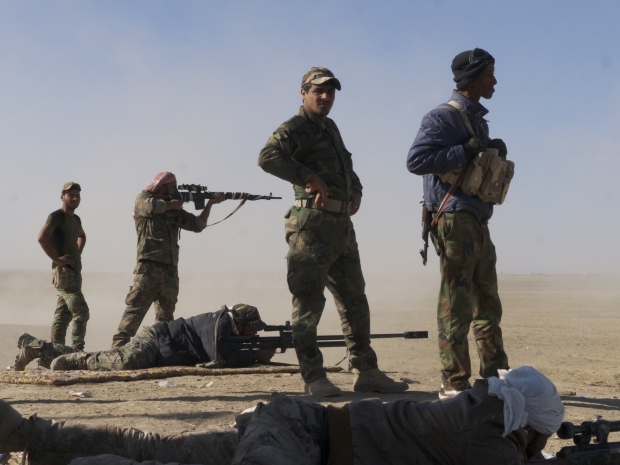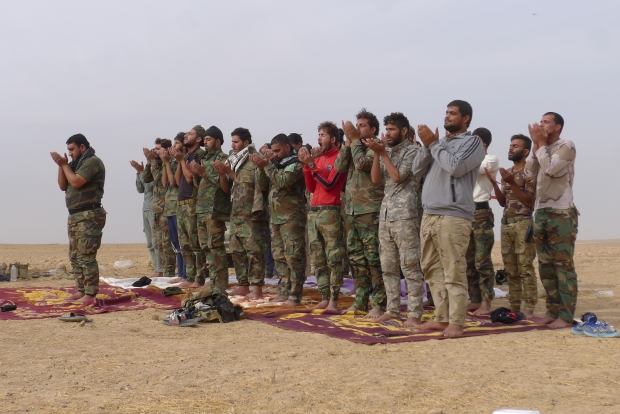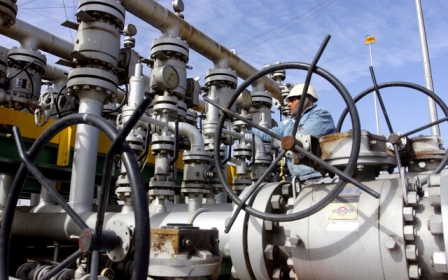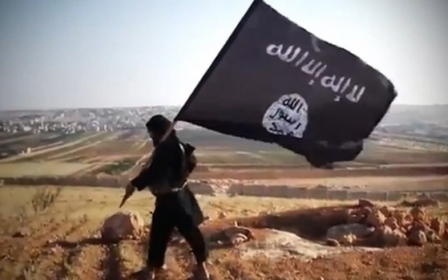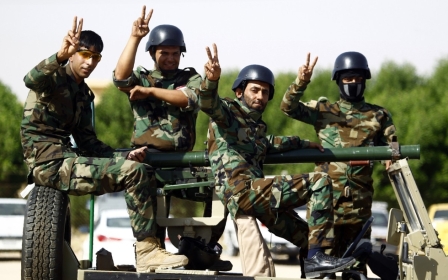Battle for Mosul: Shia-led fighters sever key IS cross-border supply route
TAL AFAR, Iraq - As black smoke rose from the airport and helicopters circled overhead, a Shia imam in traditional robes walked peacefully through the dust-filled air beside a convoy of tanks and armoured Humvees advancing into Islamic State (IS) territory.
He remained on the frontline, assuring fighters that God would protect them, unperturbed by the sharp whizz of incoming sniper fire and oblivious to concerned cries of “sierra, sierra (car car)” when fighters spotted a speeding trail of dust from an approaching IS suicide car bomb.
The imam urged calm as the soldiers’ victorious cries could be heard after an Abrams tank destroyed the car bomb in a huge blast that sent shrapnel flying, killing one.
This is the frontline in the battle for Mosul. On Thursday, Iraq’s forces took control of the strategic Tal Afar airport from IS after Iraqi army helicopters and ground forces had pounded militant positions for days, penetrating a strong defence that included multiple suicide car bombs.
The Iranian-backed Shia-majority Hashd al-Shaabi (Popular Mobilisation Units or PMUs) forces took 50km of desert territory in a four-day offensive that brought them to a kilometre away from the airport and six kilometres from the city, which IS has controlled for more than two years.
After fierce fighting, they surrounded the airport and cut the road to Syria that has used by IS for the last two years.
“We are now in the process of cutting the main supply road between Mosul and Raqqa, which runs behind the airport. It was crucial for us to clear all this area to the west and cut the road so the Iraqi army can clear Mosul of IS without them being able to flee.”
As the advance continued, vehicles in enemy territory could be seen speeding eastwards. PMU forces, unable to guarantee these were IS militants and not fleeing civilians, did not fire on them, focusing on monitoring the desert terrain for any trail of sand being kicked up by the next incoming suicide car bomb and building sand berms to protect their newly claimed positions.
'IS fighters in Tal Afar are considered to be the strongest and, in this area we have encountered some of the strongest resistance and worst fighting we have seen'
Hadi Al-Ameri, PMU commander
Abadi said hundreds of IS fighters had put up substantial resistance attempting to defend the route, which became a lifeline for IS’s operations in Mosul as well as their final path of escape and resupply. In the hills between the airport and the Tal Afar city, IS militants fought from a series of trenches, and fighters said when they liberated the area, they found the dug-outs full of IS corpses.
IS 'producing weaponised mustard gas': Watchdog
“IS fighters in Tal Afar are considered to be the strongest and in this area we have encountered some of the strongest resistance and worst fighting we have seen,” said Hadi Al-Ameri, commander of the PMUs' powerful Badr Brigade, units of which are spearheading the frontlines around Tal Afar.
“But neither this nor the challenging terrain has stopped us. We have the airport surrounded, we now control the area south-west of Mosul and we will continue advancing until we close the borders between Iraq and Syria.”
On the frontlines, IS firepower seemed limited to snipers and 12.7 calibre machine guns, and there was no evidence that militants had put mortars or heavy weaponry in place to defend the airport. Commander Abu Turrab said IS’s resistance had proved to be weaker than anticipated, adding that intelligence reports showed militants were mainly returning fire as they fled rather than actively defending their positions.
A stronger defence of Tal Afar city itself was expected, he said. Across the open desert terrain, IS’s strategy relied on suicide car bombs and hand-made armed drones, which did nothing to stop the relentless and highly organised advance of PMU forces.
“This is the third armed drone we have shot down in two days,” said Turrab, holding up the remains of a polystyrene plane held together with industrial tape, its mechanisms hanging limply from the body. “This one dropped two bombs before we could shoot it down but thankfully no one was hurt.”
“There were 28 mines on this hill alone because IS know that we focus on taking higher ground, for the view it affords, and we successfully dismantled them all,” said 23 year-old bomb disposal and IED expert Hmaidan, speaking from a mound overlooking the airport. “We know the airport will be full of IEDs and mines and we will start clearance operations immediately, so the troops can safely move inside.”
Although some soldiers are already inside the airport, IED clearance operations are expected to take several days before the PMU forces can safely move large brigades into the area and continue their advance to the outskirts of Tal Afar.
The PMUs do not have a mandate to enter the predominantly Sunni city of Tal Afar, also populated by many Iraqi Turkmen, among others. Their presence in the area has already been vehemently opposed by Turkish President Recep Tayyip Erdogan.
Commander Ameri described Erdogan’s comments on Tal Afar as counterproductive and politically more detrimental to Turkey than to Iraq. He reiterated the limitations of the PMUs' mandate in the area and confirmed his forces would hand over operations to Turkmen units once they reached the outskirts of Tal Afar.“According to our plans, we will lead the battle to the city’s outskirts and then the sons of Tal Afar will be responsible for taking their city back,” Ameri said, explaining that Turkmen and other Sunni brigades from the PMUs would be supported by Turkmen Federal Police units. “But, if they ask for our help, of course we will give it.”
Since operations to free Mosul began in October, the 140,000-strong PMUs have liberated more than 1,300sq km of territory formerly held by IS, including more than 60 villages.
The Shia-majority forces have sparked some controversy because of alleged abuses in their fight against IS in traditionally Sunni territory, but PMU media head Haji Muhunnud Aqabi insisted the force represented all the people of Iraq.
“We have around 30,000 Sunni fighters with us and another 10,000 Christians and other faiths, such as Yazidi and Ashaback, who are Iraqis from Mosul of mixed faiths,” he said. “There is nothing in the world like IS - they burned churches and mosques, made women into slaves and displaced thousands of people, so anyone who is fighting against IS should be supported. We want peace in Iraq for everyone.”
New MEE newsletter: Jerusalem Dispatch
Sign up to get the latest insights and analysis on Israel-Palestine, alongside Turkey Unpacked and other MEE newsletters
Middle East Eye delivers independent and unrivalled coverage and analysis of the Middle East, North Africa and beyond. To learn more about republishing this content and the associated fees, please fill out this form. More about MEE can be found here.


